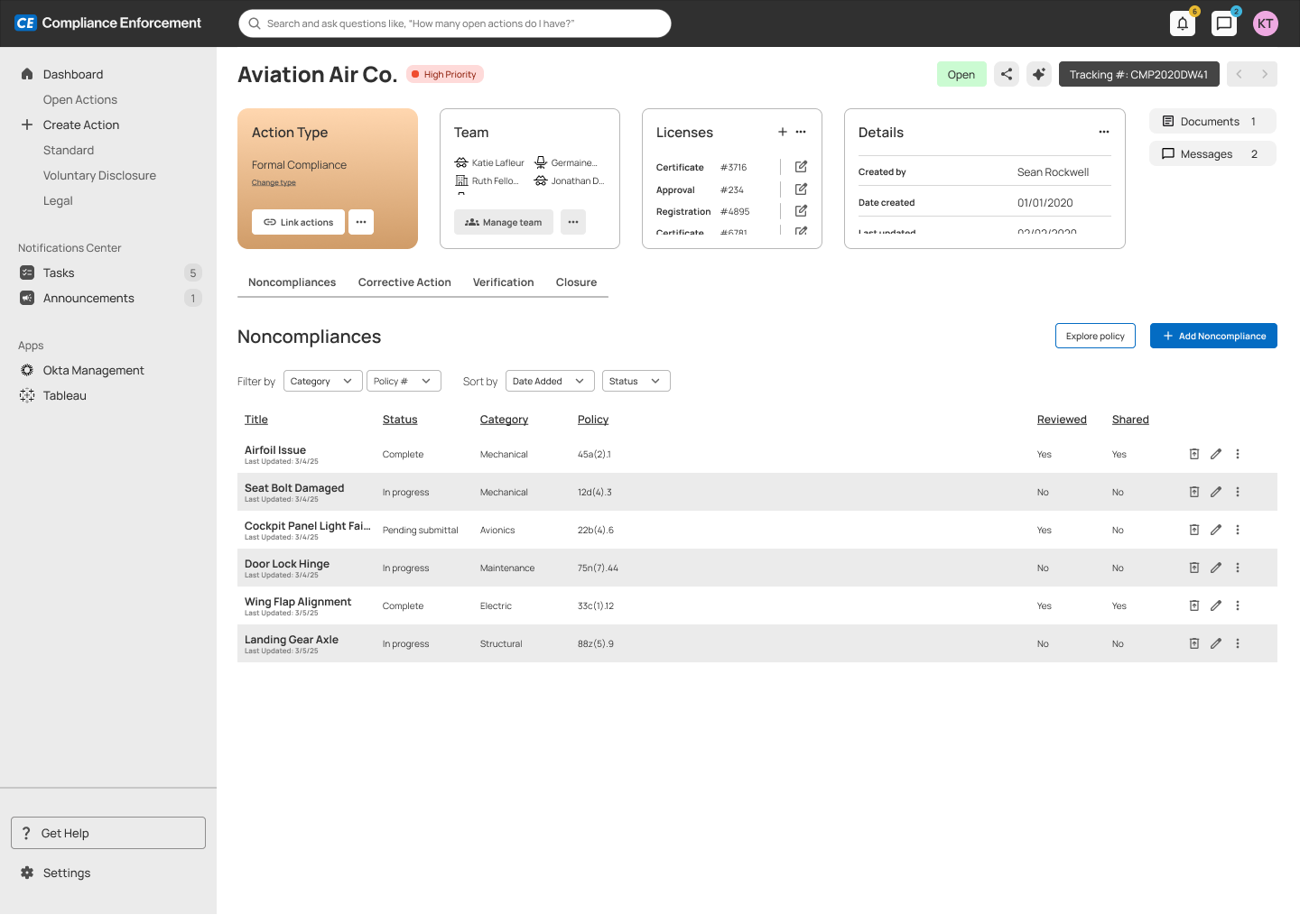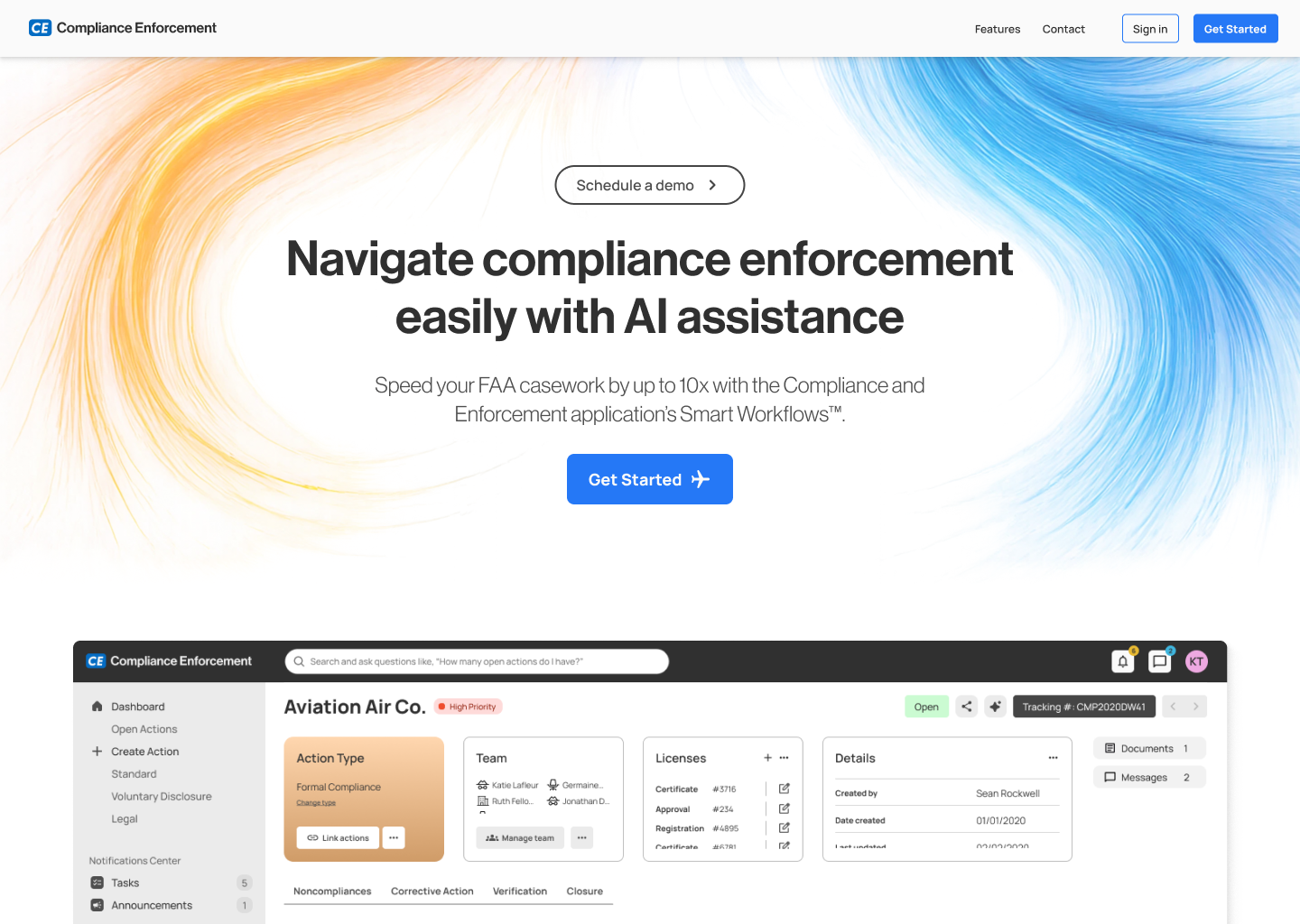Flight Safety at Scale — Digitizing compliance processes for the FAA
The Federal Aviation Administration (FAA) oversees thousands of aviation compliance cases each year. But their existing processes (analog, manual, and fragmented) were slowing down operations and leaving room for error. The FAA funded the development of the Compliance and Enforcement Application (CEA) to digitize and streamline these efforts, but previous attempts had fallen short, resulting in costly rework.
To chart a better course, as UX Lead, I developed and executed a repeatable UX process that helped the FAA turn complexity into clarity, building a system that truly supported staff, met regulatory standards, and enabled faster, more effective compliance processing.
This case study is a conceptual example and does not reflect any actual FAA systems, internal processes, or operational data. Any features or workflows described are generalized representations based on publicly available information and do not indicate or reveal the functionality, design, or capabilities of any real FAA applications.
ClientFAAServicesUX Lead, Planning, Workshops, Design System, Prototyping, Journeys, ResearchYear2019-2021
Background & Objectives
A Mission to Modernize
The FAA’s Compliance and Enforcement Application (CEA) was envisioned as a single platform to manage investigations, compliance actions, and enforcement decisions. Early digital efforts struggled to capture the complexity of FAA policies and workflows, leading to delays and inefficiencies. Facing growing stakeholder skepticism, the agency shifted course — prioritizing research, user-centered design, and clear, actionable requirements from the start.
Laying the Foundation for Long-Term Success
Rather than rushing a quick solution, the FAA recognized the need for a deliberate, user-centered approach. Building a system to support complex compliance workflows required more than digitization; it required clear understanding of policies, processes, and user needs at every level.
Challenges
Complex Policy Interpretation
The CEA needed to support intricate FAA compliance policies. Many of which were dense, technical, and open to interpretation. Understanding and translating these regulations into usable digital workflows required deep analysis and close collaboration with subject matter experts.
Ambiguous and Evolving Requirements
At project kickoff, requirements were often high-level or incomplete. To succeed, we needed a strategy for rapidly defining, validating, and refining requirements in partnership with users and policy owners while staying flexible to inevitable changes.
Fragmented Knowledge Across Teams
No single expert had full end-to-end knowledge of the compliance processes. Information lived across different departments and roles, making it critical to systematically map workflows, identify gaps, and build a shared understanding among stakeholders.
High Standards for Usability and Compliance
Beyond functionality, the system had to meet strict usability, accessibility, and compliance standards. It wasn’t enough to be technically correct. The platform needed to be intuitive, efficient, and fully aligned with FAA’s operational realities to gain lasting adoption.
Complex Policy Interpretation
The CEA needed to support intricate FAA compliance policies. Many of which were dense, technical, and open to interpretation. Understanding and translating these regulations into usable digital workflows required deep analysis and close collaboration with subject matter experts.
Ambiguous and Evolving Requirements
At project kickoff, requirements were often high-level or incomplete. To succeed, we needed a strategy for rapidly defining, validating, and refining requirements in partnership with users and policy owners while staying flexible to inevitable changes.
Fragmented Knowledge Across Teams
No single expert had full end-to-end knowledge of the compliance processes. Information lived across different departments and roles, making it critical to systematically map workflows, identify gaps, and build a shared understanding among stakeholders.
High Standards for Usability and Compliance
Beyond functionality, the system had to meet strict usability, accessibility, and compliance standards. It wasn’t enough to be technically correct. The platform needed to be intuitive, efficient, and fully aligned with FAA’s operational realities to gain lasting adoption.
1. Establishing a Shared Foundation
I began by mining official FAA policy documents, the most reliable sources of truth we had. I translated complex regulations into detailed service blueprints to visualize how processes should function digitally. These blueprints became powerful tools for facilitating workshops with subject matter experts and users, helping us validate workflows and align system requirements with real operational needs.
2. Defining Requirements Through Collaboration
Using the service blueprints as a starting point, I worked closely with stakeholders to structure detailed user stories within the Scaled Agile Framework (SAFe).
Through sketching sessions, process mapping, and early concept drafts, I helped transform high-level needs into clearly defined, user-centered requirements; creating a shared foundation that guided our design efforts.
3. Prototyping with User-Centered Precision
With validated requirements in place, I led the prototyping process, drafting mockups within the FAA’s existing design system and expanding it thoughtfully where new components were needed.
I incorporated early feedback through usability testing and preference testing, refining designs iteratively to ensure they were intuitive, accessible, and fully aligned with user expectations before moving into development handoff.
4. Delivering with Confidence and Clarity
Recognizing the complexity of the system, I didn’t stop at just handing off interactive prototypes.
I created comprehensive supporting materials: annotated designs, responsive behavior guidelines, and updated service blueprints while partnering directly with developers through live walkthroughs, story pointing, and backlog refinement sessions. This ensured the designs were understood, scoped appropriately, and built with accuracy and efficiency.
Results
Operational Efficiency
FAA staff process compliance cases up to 10 times faster, with a 35% improvement in accuracy—streamlining operations and boosting reliability.
Cost Savings
Upfront investments in research and strategy saved tens of thousands of dollars by avoiding costly mid-project rework and streamlining delivery.
On-Time Delivery
Features were delivered on schedule, aligned with real needs, and guided by a clear process that kept development focused and efficient.
Consistent Quality
Each release strengthened stakeholder trust by delivering reliable, high-quality features that met operational needs and supported long-term goals.


